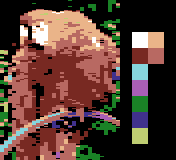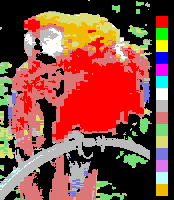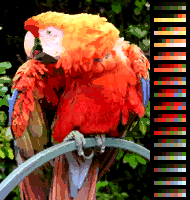|
List of color palettes
This article is a list of the color palettes for notable computer graphics, terminals and video game console hardware. Only a sample and the palette's name are given here. More specific articles are linked from the name of each palette, for the test charts, samples, simulated images, and further technical details (including references). In the past, manufacturers have developed many different display systems in a competitive, non-collaborative basis (with a few exceptions, as the VESA consortium), creating many proprietary, non-standard different instances of display hardware. Often, as with early personal and home computers, a given machine employed its unique display subsystem, with its also unique color palette. Also, software developers had made use of the color abilities of distinct display systems in many different ways. The result is that there is no single common standard nomenclature or classification taxonomy which can encompass every computer color palette. In order to organize the material, color palettes have been grouped following arbitrary but rational criteria. First, generic monochrome and full RGB repertories common to various computer display systems. Second, usual color repertories used for display systems that employ indexed color techniques. And finally, specific manufacturers' color palettes implemented in many representative early personal computers and videogame consoles of various brands. The list for personal computer palettes is split into two categories: 8-bit and 16-bit machines. This is not intended as a true strict categorization of such machines, because mixed architectures also exist (16-bit processors with an 8-bit data bus or 32-bit processors with a 16-bit data bus, among others). The distinction is based more on broad 8-bit and 16-bit computer ages or generations (around 1975–1985 and 1985–1995, respectively) and their associated state of the art in color display capabilities. Here is the common color test chart and sample image used to render every palette in this series of articles: See further details in the summary paragraph of the corresponding article. List of monochrome and RGB palettesFor the purpose of this article, the term monochrome palette means a set of intensities for a monochrome display, and the term RGB palette is defined as the complete set of combinations a given RGB display can offer by mixing all the possible intensities of the red, green, and blue primaries available in its hardware. These are generic complete repertories of colors to produce black and white and RGB color pictures by the display hardware, not necessarily the total number of such colors that can be simultaneously displayed in a given text or graphic mode of any machine. RGB is the most common method to produce colors for displays; so these complete RGB color repertories have every possible combination of R-G-B triplets within any given maximum number of levels per component. For specific hardware and different methods to produce colors than RGB, see the List of computer hardware palettes and the List of video game consoles sections. For various software arrangements and sorts of colors, including other possible full RGB arrangements within 8-bit depth displays, see the List of software palettes section. Monochrome palettesThese palettes[1] only have some shades of gray.
Dichrome palettesEach permuted pair of red, green, and blue (16-bit color palette, with 65,536 colors). For example, "additive red green" has zero blue and "subtractive red green" has full blue. Regular RGB palettesThese full RGB palettes employ the same number of bits to store the relative intensity for the red, green and blue components of every image's pixel color. Thus, they have the same number of levels per channel and the total number of possible colors is always the cube of a power of two. It should be understood that 'when developed' many of these formats were directly related to the size of some host computers 'natural word length' in bytes—the amount of memory in bits held by a single memory address such that the CPU can grab or put it in one operation.
Non-regular RGB palettesThese are also RGB palettes, in the sense defined above (except for the 4-bit RGBI, which has an intensity bit that affects all channels at once), but either they do not have the same number of levels for each primary channel, or the numbers are not powers of two, so are not represented as separate bit fields. All of these have been used in popular personal computers.
List of software palettesSystems that use a 4-bit or 8-bit pixel depth can display up to 16 or 256 colors simultaneously. Many personal computers in the later 1980s and early 1990s displayed at most 256 different colors, freely selected by software (either by the user or by a program) from their wider hardware's color palette. Usual selections of colors in limited subsets (generally 16 or 256) of the full palette includes some RGB level arrangements commonly used with the 8 bpp palettes as master palettes or universal palettes (i.e., palettes for multipurpose uses). These are some representative software palettes, but any selection can be made in such types of systems. System specific palettesThese are selections of colors officially employed as system palettes in some popular operating systems for personal computers that feature 8-bit displays. RGB arrangementsThese are selections of colors based on evenly ordered RGB levels, mainly used as master palettes to display any kind of image within the limitations of the 8-bit pixel depth.
Other common uses of software palettes
List of computer hardware palettesIn early personal computers and terminals that offered color displays, some color palettes were chosen algorithmically to provide the most diverse set of colors for a given palette size, and others were chosen to assure the availability of certain colors. In many early home computers, especially when the palette choices were determined at the hardware level by resistor combinations, the palette was determined by the manufacturer. Many early models output composite video colors. When seen on TV devices, the perception of the colors may not correspond with the value levels for the color values employed (most noticeable with NTSC TV color system). For current RGB display systems for PC's (Super VGA, etc.), see the 16-bit RGB and 24-bit RGB for HighColor (thousands) and TrueColor (millions of colors) modes. For video game consoles, see the List of video game consoles section. For every model, their main different graphical color modes are listed based exclusively in the way they handle colors on screen, not all their different screen modes. The list is ordered roughly historically by video hardware, not grouped by branch. They are listed according to the original model of every system, which implies that enhanced versions, clones and compatibles also support the original palette. Terminals and 8-bit machines
16-bit machines
Video game console palettesColor palettes of some of the most popular video game consoles. The criteria are the same as those of the List of computer hardware palettes section.
See also
References
|







































































